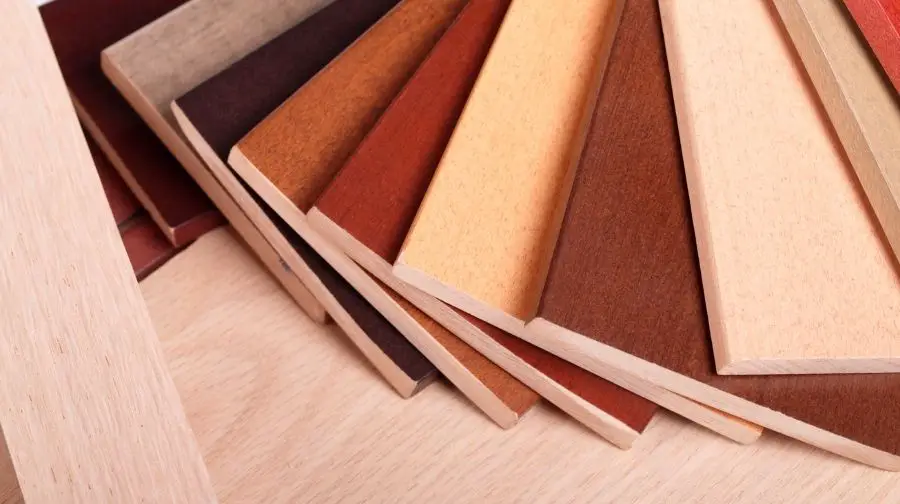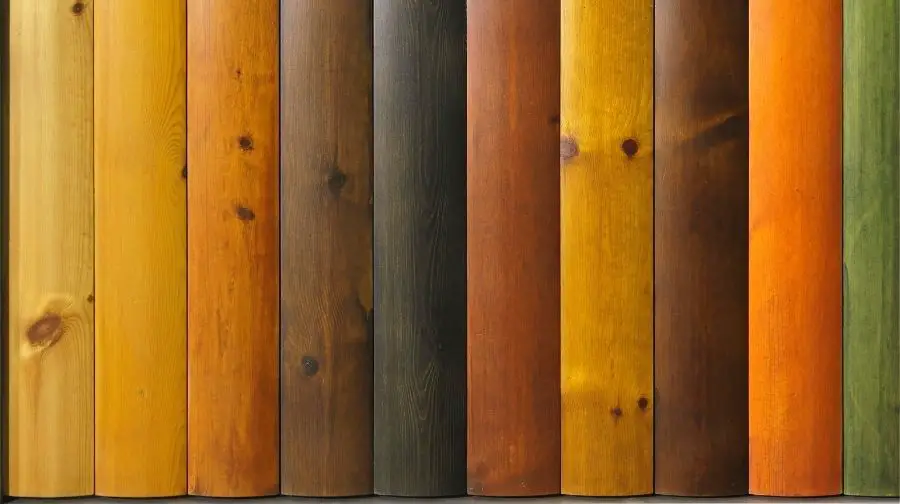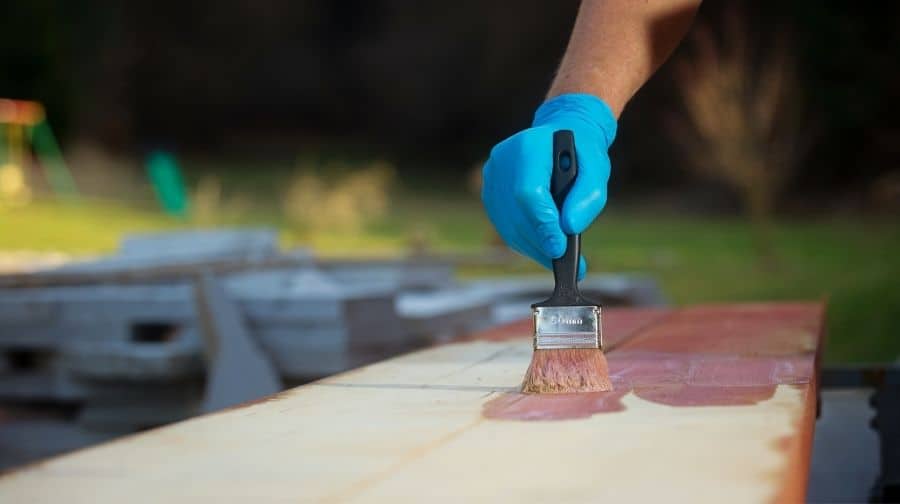
The technique of staining may significantly improve the appearance of wooden furniture or boards. Wood stains come in a variety of styles and hues. And with the right mix, you can bring out the glitz of the piece you are working on and provide your wood with the appearance that matches your concept exactly.
Wood stain is a sort of liquid paint-like material that, when properly applied, enters the wood’s body and bonds inside. It does not just sit on top of the wood as paint does. As a result, the colour is absorbed into the wood, making it less prone to fade.
The stain work lasts a long time in the wood. However, the time it takes for the coating to dry once applied on the wood surface is also essential. You will not be able to use your item until the wood stain has completely dried. We all want to wait as little as feasible for the wood stains to settle because time is essential.
Table of Contents
Factors that influence drying time
- Temperature
The temperature has a significant impact on how long wood stains need to dry. According to experts, if the stained wooden item’s atmosphere is warm, the stain job will dry faster than if it is cold.
The chemicals in wood stains tend to dissipate more quickly in warmer temperatures. The wood’s solvent is then evaporated, leaving just the solute within. The solute is the deep tone of the wood after it has been stained.
- Humidity
Humidity is the second most substantial factor affecting stain drying time. Humidity is a measurement of the amount of moisture in the surrounding air. As a result, it is apparent from the definition that there will be more water vapor in a humid environment. This moisture, in most cases, influences how long it takes for a stain to dry. The more moisture the longer dry time.
Keeping these two problems in mind, here are some remedies for speeding up the drying of paints.
How To Dry Wood Stain Faster
- Enhance temperature with a heater
Using permanent or portable heating equipment to raise the temperature can help to dry the wood stains faster. If you are working indoors, it is a unique method to speed up the drying of wood stains. The temperature steadily rises when the heater is turned up.
As a result, all of the liquid chemicals inside the stain begin to heat up. It evaporates as it reaches the correct temperature, leaving just the solute left. As a consequence, the wooden object receives an A-grade stain job with little drying time.
- Decrease humidity of the air
Humidity, as we all know, has a significant effect on stain fading time. When the humidity is low, the air seeks to pull moisture from anywhere it can to maintain balance. Indoor air conditioners are helpful in this situation.
If you have an automated air conditioner, your room probably has a low humidity level. You may also use the remote to lower the humidity manually. When the space reaches a low humidity level, the solvent from the wood stain will begin to operate, speeding up the drying process.
- Make a proper arrangement for ventilation
The lack of sufficient ventilation causes the stain not to penetrate the wood effectively. Therefore, if you want to ensure that the wood absorbs all of the stain effectively, you must ensure that the space is well ventilated.
There will be no residual fumes from the vaporized solvents in a well-ventilated area, and the stain will infiltrate and absorb rapidly. The wood stain will dry quickly as a result of this. To guarantee sufficient ventilation, simply open a window or two.
- Place the work piece outdoors
Why not give it a try if the outside atmosphere is warmer and less humid and typically has excellent ventilation? But, many people think about how long it should take to dry if they place the work piece outside. That question has a range of answers ranging from 24 to 72 hours.
As a result, it is recommended that you do not move or touch the discoloured area for at least one day. And, if the natural climate is conducive to drying wood stains rapidly, putting the stained wood object outside may be the best option.
- Apply a dehumidifier
If you do not have a suitable air conditioner in your shop, a portable dehumidifier is a good option. It is an excellent method for reducing humidity in a closed environment. This operates similarly to an air conditioner but offers a broader range of humidity control.

Dry Oil-Based Wood Stain Faster
Oil-based stains, for example, can be sprayed with a fine lacquer thinner to speed up the drying procedure. Most of the oil-based stains are dry to be touched within a single or couple of hours, and a recoat may be applied in about 2 hours. Before using a topcoat, allow for an 8-hour (minimum) drying time. The usual drying time for extrinsic stain (or outdoor objects that will be stained) is between 24 and 72 hours. It is suggested that you use a finishing product that is suitable for the agent.
Oil-based stains definitely require some drying time; however, there is some misunderstanding over the appropriate length of drying time. When it comes to oil-based stains, there are numerous elements to consider, as well as “suggested” periods. However, many individuals adhere to a minimal time requirement, and the application technique might really influence the drying time.
Speeding Up The Drying Time-Oil Based Finish
Subscribe to Chris Cute on Youtube
Why Is My Wood Stain Still Sticky?
Due to lack of a binder, such as that found in paint or varnish, stain sticks to a wooden surface. When the solvent has evaporated, all that is left is the pigments and the oil in which it is suspended. Simply apply another thick layer of stain to eliminate it. Allow 5 minutes for the new stain to dissolve the old one. When you wipe it away with a rag, the sticky paint will come off with it.
If you do not have any additional stain or are unsure if the stain you possess fits the existing one, you can dilute the previous stain with lacquer thinner. Then, because it evaporates fast, apply it with a paintbrush and wipe it off promptly. If you employ this approach, you will probably remove part of the stain from the woodwork and lighten the overall color.
Woodworking Glue And Finish Problems
Subscribe to Steve Ramsey’s Personal Channel on Youtube
Will Tacky Stain Eventually Dry?
Penetrating wood stains are not developed to be used for surface finishing purposes. They will not dry properly if the stain is applied too heavily and will stay sticky to the touch. The excess stain will dissolve and wash away, leaving just the pigment that has permeated the wood.
If you painted the stain correctly but it stayed tacky, it might be because of rain or excessive humidity. Give it a couple of additional days to see if it gets better. Another option is that the stain was older or from a faulty batch.
How Can You Tell If A Stain Is Dry?
There are a few different techniques to tell if a surface is dry: If an oil-based stain is no longer sticky and has no odor, it is considered dry. WATER-BASED stains are dry when they no longer feel cold to be touched, and a powder forms with a mild sanding.
Should Stain Be Sticky After Drying?
If you do not wash away the extra stain after you apply it, there is a high chance that the stain may remain sticky. Therefore, you should not use your clean topcoat till the stain is no longer sticky and has dried for at least the amount of time specified on the package.
Easy Solutions to Common Staining Problems
Subscribe to MinwaxUSA on Youtube
What Happens If You Put Polyurethane Over A Tacky Stain?
You will wind up with stain mixing with your polyurethane. It takes time to cure, or worse if you add polyurethane before the stain is completely dry. In certain situations, putting polyurethane over wet paint reduces the polyurethane’s bonding capacity, resulting in a ruined finish over time.
Will Mineral Spirits Remove A Tacky Stain?
Mineral spirits may remove oil-based wood stains and coatings and sticky sap outdoors, and adhesive left behind from stickers. Mineral spirits can be used to wipe paints and paintbrushes.
Because it dissolves almost everything, water is sometimes referred to as the “universal solvent.” But it cannot dissolve oils. Mineral spirits come into play here. Mineral spirits are a type of solvent that may be used to dissolve oil.We live in an era where time is money; it is only reasonable to desire to complete your task as soon as possible. However, because the application of wood stains is usually only a tiny portion of the job, waiting for it to settle is inconvenient. Therefore, knowing how to set wood stains quickly is essential.
Wooden items may be stained to change their appearance completely. But, on the other hand, wood staining when done well may enhance the beauty of the woodwork and bring it to life. So, now that you have figured out how to make wood staining a lot more efficient and time-consuming, it is time to get to work.





